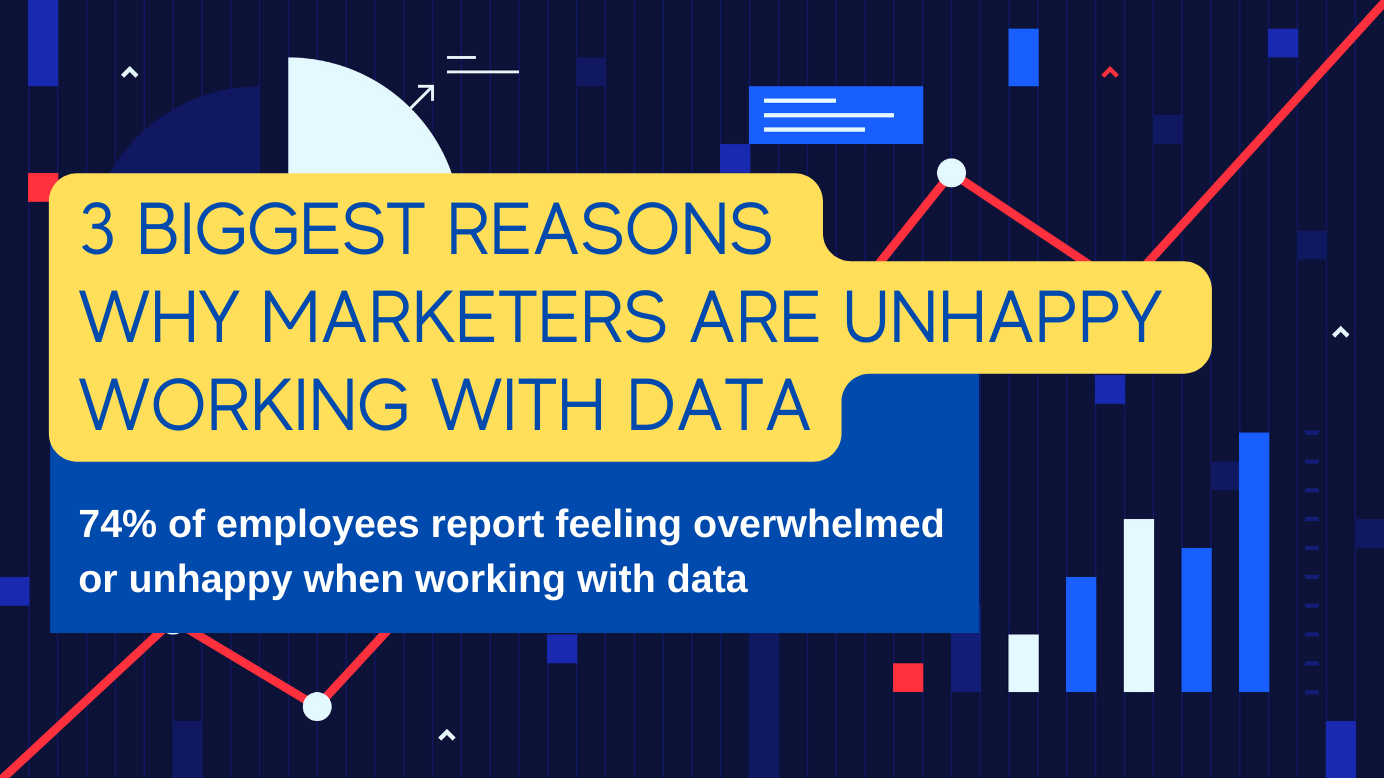
3 Biggest Reasons Why Marketers Are Unhappy Working with Data
74% of employees report feeling overwhelmed or unhappy when working with data. (#1)
I came across this data and was surprised since I enjoy working with data in marketing. Although I do get frustrated at times when my SQL doesn't provide the right output as I expected, I still manage to enjoy the process of facing data to answer important business questions.
Reading further into the report, most employees feel unproductive, frustrated, or stressed when working with customer relationship management (CRM) systems, resource planning, data analytics, business intelligence, and communication tools.

I think this stats is not talking about the same kind of "data," so it depends on what type of data we're referring to. If it's marketing data, which typically involves tables with multiple columns and rows of numbers from various marketing data sources, I'm not surprised that people would feel overwhelmed and unhappy.
So I will assume the report does not refer to data visualization, such as graphs and visualizations of marketing metrics where insights are already charted out, such as traffic and conversion rates by time and channels.
Reflecting on my experience, the following are three major reasons why I feel employees are overwhelmed and unhappy when working with data.
Lack of actionable insights
We're still not harnessing the power of data. Employees must work with data to get actionable insights, and this is where they struggle.
There are so many tools and dashboards that provide various metrics and KPIs, but it isn't easy to know what really works for our business and how we can use them effectively.
Many businesses have failed to recognize employees' important role in data strategies. Often, companies will give data to employees and expect them to be successful. Unfortunately, this can affect how confident people feel in working with data and their appetite to use it.
So much data to analyze, fear of missing something important
With the rise of big data, it's estimated that more than 80% of all data has been created in recent years. This is both good and bad news for employees because there will be an even greater supply of information they need to consume. But, on the other hand, it could give employees a sense of fear, thinking about how much data there is, and feeling some critical insights have been missed.
Although employees can feel they've missed analyzing something important, in reality, it's more important that they focus on what information will provide the most value to them and their teams.
It takes too much time to prepare data for analysis.
Data preparation is time-consuming and arduous. It takes the longest amount of time because it involves a lot of manual work to transfer data from one tool to another or clean up messy datasets. Datasets also need to be transformed, formatted, and aggregated for analysis purposes.
I don't blame employees who are overwhelmed when working with data, especially for those marketers who have to work with multiple data sources.
Free 100+ Marketing Stats for Download
A Hand-Curated List of the Latest Marketing Stats
Get Your FREE Copy HereWhat marketers can do to be more data-driven
Avoid bad data with good data collection practice.
I come across so many businesses where they're working off bad data. Usually, the tag manager is not deploying the tags properly. So ironically, many marketers are not only overwhelmed with data, but they're dealing with bad data.
I highly recommend auditing and understanding the integrity of the data you're working with. Good data practice leads to more confidence in the data.
Outsource the data enablement and management.
Working with data is one thing, but the technical knowledge to enable and manage data requires a technical background.
If you're a marketer, you can be data-driven, but that doesn't mean you have to take on the role of a data engineer. So hire the right agency partner if necessary, and get support to make working with data more pleasant.
Start with a business question.
Lastly, make sure you start with a business question. Even if it sounds simple, I've come across many data projects where businesses don't know what they're looking for.
They jump right into the data without thinking about why they want to use the data and what they plan to do with it.
When employees have access to great data, they may feel overwhelmed because there's no clear direction for their analysis.
The best way to get started with data analytics is by asking yourself a specific question. This will help you map out the information and provide employees more confidence when working on projects that involve analyzing data, which leads them towards success in their careers.
Sources
(1) wiisdom "BUSINESS INTELLIGENCE TRENDS 2020" https://wiiisdom.com/ebook/business-intelligence-trends-2020/
(2) Accenture "The Human Impact of Data Literacy" https://www.accenture.com/_acnmedia/PDF-115/Accenture-Human-Impact-Data-Literacy-Latest.pdf
(3) Datanami "Data Prep Still Dominates Data Scientists’ Time, Survey Finds" https://www.datanami.com/2020/07/06/data-prep-still-dominates-data-scientists-time-survey-finds/
ZoomMetrix Newsletter
Join the newsletter to receive the latest updates in your inbox.